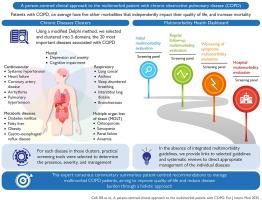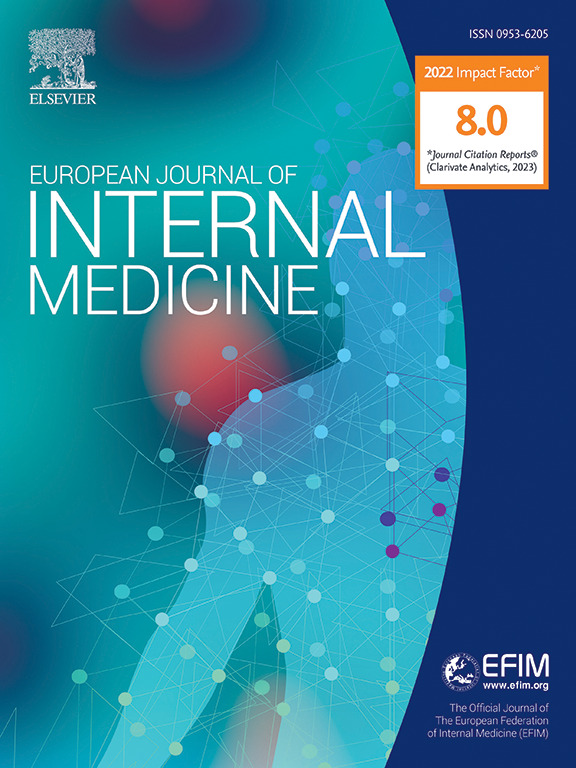A person-centred clinical approach to the multimorbid patient with COPD
IF 6.1
2区 医学
Q1 MEDICINE, GENERAL & INTERNAL
引用次数: 0
Abstract
Most patients with a chronic disease are multimorbid. This is particularly important in patients with chronic obstructive pulmonary disease (COPD), who on average have five other identified comorbidities that independently impact their health and increase their mortality risk. Using a modified Delphi method, we selected the 20 most important diseases associated with COPD and clustered them into five domains: mental, respiratory, cardiovascular, metabolic and multiple organs loss of tissue. We then developed a systematic approach to characterise the impact and clinical presentation of individual diseases within each cluster, and to define the priority and timing of measurement of the potential markers of disease presence and severity. Given the absence of integrated guidelines to treat multimorbid patients, we reviewed and selected individual disease guidelines or recommendations that can be accessed for specific information related to the management of each disease. In addition, we built a multimorbidity ‘Health Dashboard’ that, completed by the patient or health practitioner, can help identify the presence and severity of comorbid diseases. By using a practical comprehensive approach, it is possible to identify and characterise important comorbid diseases in patients with COPD, and to implement management tools that should help improve their outcome. This expert consensus commentary summarises patient-centred recommendations to manage comorbidities in COPD patients, aiming to improve quality-of-life and reduce disease burden through a holistic approach. Prospective pragmatic trials comparing such an approach with usual care for multimorbid patients with COPD including long-term follow-up are urgently needed.

以人为本的临床方法治疗多病COPD患者。
大多数慢性疾病患者都是多病的。这对慢性阻塞性肺疾病(COPD)患者尤其重要,他们平均有其他五种已确定的合并症,这些合并症独立地影响他们的健康并增加他们的死亡风险。采用改进的德尔菲法,我们选择了与COPD相关的20种最重要的疾病,并将其分为5个领域:精神、呼吸、心血管、代谢和多器官组织损失。然后,我们开发了一种系统的方法来描述每个集群中单个疾病的影响和临床表现,并定义疾病存在和严重程度的潜在标记物的优先级和测量时间。鉴于缺乏治疗多病患者的综合指南,我们审查并选择了可获取与每种疾病管理相关的特定信息的单个疾病指南或建议。此外,我们建立了一个多病“健康仪表板”,由患者或保健医生完成,可以帮助确定共病疾病的存在和严重程度。通过使用实用的综合方法,有可能识别和描述COPD患者的重要合并症,并实施有助于改善其预后的管理工具。本专家共识评论总结了以患者为中心的建议,以管理慢性阻塞性肺病患者的合并症,旨在通过整体方法改善生活质量并减轻疾病负担。迫切需要将这种方法与常规治疗方法(包括长期随访)进行比较的前瞻性实用试验。
本文章由计算机程序翻译,如有差异,请以英文原文为准。
求助全文
约1分钟内获得全文
求助全文
来源期刊
CiteScore
9.60
自引率
6.20%
发文量
364
审稿时长
20 days
期刊介绍:
The European Journal of Internal Medicine serves as the official journal of the European Federation of Internal Medicine and is the primary scientific reference for European academic and non-academic internists. It is dedicated to advancing science and practice in internal medicine across Europe. The journal publishes original articles, editorials, reviews, internal medicine flashcards, and other relevant information in the field. Both translational medicine and clinical studies are emphasized. EJIM aspires to be a leading platform for excellent clinical studies, with a focus on enhancing the quality of healthcare in European hospitals.

 求助内容:
求助内容: 应助结果提醒方式:
应助结果提醒方式:


